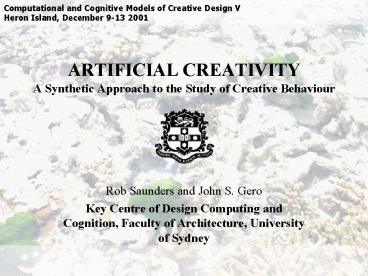ARTIFICIAL CREATIVITY A Synthetic Approach to the Study of Creative Behaviour - PowerPoint PPT Presentation
1 / 32
Title:
ARTIFICIAL CREATIVITY A Synthetic Approach to the Study of Creative Behaviour
Description:
Key Centre of Design Computing and Cognition, Faculty of ... Variegated agents. E.g. consumers, distributors, critics, clients. Complex interactions ... – PowerPoint PPT presentation
Number of Views:232
Avg rating:3.0/5.0
Title: ARTIFICIAL CREATIVITY A Synthetic Approach to the Study of Creative Behaviour
1
ARTIFICIAL CREATIVITYA Synthetic Approach to the
Study of Creative Behaviour
- Rob Saunders and John S. Gero
- Key Centre of Design Computing and Cognition,
Faculty of Architecture, University of Sydney
2
OUTLINE
- Why do we need a new approach?
- Limitations of other approaches.
- What is artificial creativity?
- Features of artificial creativity systems.
- How to implement artificial creativity.
- Example The Digital Clockwork Muse.
3
MODELS OF CREATIVITY
- Models of Personal Creativity
- Creative idea is novel to individual.
- Models of Socio-Cultural Creativity
- Creative idea is novel to society.
- Unified Models of Creativity
- E.g. Bodens P-creativity H-creativity,
Gardners little-c and big-C creativity.
4
PROBLEMS MODELLING HUMAN SOCIO-CULTURAL CREATIVITY
- Requires sophisticated models.
- Complex systems or small domains.
- Requires long timescales to evaluate.
- Human evaluation is time consuming.
- Difficult to identify essential elements.
- Is a feature of a complex computational system an
essential element of a creative system or a
detail of the domain?
5
COHEN AARON A SOCIO-CULTURAL CREATIVE SYSTEM?
- Harold Cohens AARON
- Traditional AI artist.
- Exhibited in galleries.
- Alongside human artists.
- Where is the creativity?
- How much of the creativityshould be attributed
to themachine?
6
ARTIFICIAL CREATIVITY
- The aim of studying artificial creativity is to
understand creativity-as-it-is in the context of
creativity-as-it-could-be to understand
creativity as found in human societies by
studying artificial creativity in societies of
agents with different social conventions. - The goals of artificial creativity include the
production of minimal models of creative systems
that display some fundamental aspects of the
socially situated creativity. - The focus of the study is on the behaviour of the
artificial creative system, not on the products
created.
7
FEATURES OF AN ARTIFICIAL CREATIVITY MODEL
- The model contains of a population of agents in
an environment. - No agent can direct the behaviour of all others.
- No rule can dictate the global behaviour of the
model. - Agents communicate locally with other agents to
exchange symbols. - Agents interact with the environment to access
cultural symbols. - Agents independently evaluate the potential
creativity of artefacts.
8
BACKGROUND
9
CSIKSZENTMIHALYIS SYSTEMS VIEW OF CREATIVITY
- Strong critic of Traditional AI models.
- Problem-solving is not the most important aspect
of creativity. - A situated approach to studying creativity.
- Studying creative individuals in creative
systems. - Where is the creativity?
- Creative processes in the interactions between
system components.
10
CSIKSZENTMIHALYIS SYSTEMS VIEW OF CREATIVITY
- Individual
- Generates ideas.
- Field
- Evaluates ideas.
- Domain
- Stores ideas.
11
LIUS DUAL GENERATE-AND-TEST MODEL OF CREATIVITY
- Unifying views and creativity.
- Attempt to unify views of Simon and
Csikszentmihalyi. - Recognised two generate-and-test loops.
- Individual and socio-cultural generate-and-test
loops. - Proposed as theoretical model.
- Not as a computational system.
12
THE PERSONAL GENERATE-AND-TEST LOOP
(b)
13
THE SOCIO-CULTURAL GENERATE-AND-TEST LOOP
14
THE DUAL GENERATE-AND-TEST MODEL
15
ARTIFICIAL CREATIVITY
16
ADAPTING THE DUAL GENERATE-AND-TEST MODEL
- A viable computational framework.
- If a reasonable test for creativity can be
implemented. - Removing the socio-cultural test.
- Incompatible with artificial creativity approach
because it represents a rule that dictates global
behaviour.
17
COMBINING PERSONAL CREATIVITY TESTS
Individual B
no
To Domain
Problem Finding
Creativity Test
Generate
yes
yes
Individual A
no
yes
Creativity Test
Problem Finding
Generate
18
DISTRIBUTING THE SOCIO-CULTURAL CREATIVITY TEST
19
THE DIGITAL CLOCKWORK MUSE
20
THE DIGITAL CLOCKWORK MUSE
- Individuals Curious design agents.
- Agents with personal creativity tests.
- The Field An economy of interest.
- Agents rewarded for generating interesting works.
- The Domain Genetic artworks.
- Artworks as designs with few requirements for
utility.
21
GENETIC ARTWORKS
This example is taken from the archive of human
evolved genetic artworks kindly provided by John
Mount, Scott Neal Reilly and Michael Witbrock as
part of the International Interactive Genetic Art
Project.
22
A TOOL-USING CURIOUS DESIGN AGENT
23
IMPLEMENTING INDIVIDUALS AS CURIOUS DESIGN AGENTS
- Detect novelty in artefacts.
- Novelty detection using a neural network.
- Model an interest in detected novelty.
- Model based on studies of human arousal.
- Explore design spaces.
- Exploration of possibilities to avoid boring
subspaces and find interesting ones.
24
MODELLING AN INTEREST IN NOVELTY THE WUNDT CURVE
HEDONIC VALUE
25
RESULTS
26
THE LAW OF NOVELTY
27
THE LAW OF NOVELTY
28
THE FORMATION OF CLIQUES
29
CONCLUSIONS
30
EMERGENT BEHAVIOUR IN THE DIGITAL CLOCKWORK MUSE
- Emergent creative styles
- Styles emerge that are considered interesting by
multiple agents. - Emergent creative individuals
- Individuals emerge that are generally regarded as
creative. - Emergent creative cliques
- Cliques emerge supporting creative individuals.
31
RELATED WORK
- Multi-agent systems.
- E.g. Coltons multi-agent mathematical discovery,
Grecu and Browns design teams. - Memetic models.
- E.g. Gaboras Memes and Variations.
- Computational sociology.
- E.g. Haag and Liedls innovation networks and
Solomon et als percolation networks.
32
FUTURE WORK
- Variegated agents
- E.g. consumers, distributors, critics, clients.
- Complex interactions
- E.g. favouritism, influence, patronage.
- Distributed domains
- Domains that are emergent from the actions and
interactions of agents.































